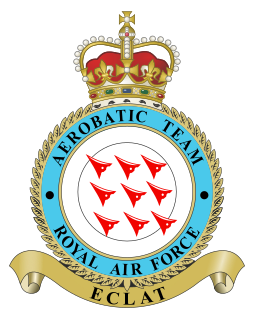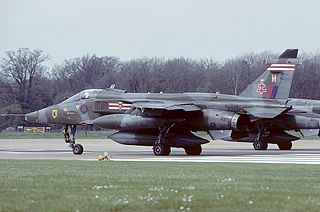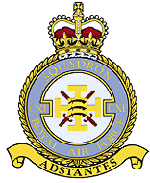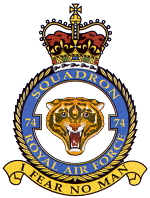
The Red Arrows, officially known as the Royal Air Force Aerobatic Team, is the aerobatics display team of the Royal Air Force based at RAF Scampton. The team was formed in late 1964 as an all-RAF team, replacing a number of unofficial teams that had been sponsored by RAF commands.

The English Electric Lightning is a British fighter aircraft that served as an interceptor during the 1960s, the 1970s and into the late 1980s. It remains the only UK-designed-and-built fighter capable of Mach 2. The Lightning was designed, developed, and manufactured by English Electric, which was later merged into the newly-formed British Aircraft Corporation. Later the type was marketed as the BAC Lightning. It was operated by the Royal Air Force (RAF), the Kuwait Air Force (KAF), and the Royal Saudi Air Force (RSAF).

The Westland Wessex is a British-built turbine-powered development of the Sikorsky H-34. It was developed and produced under licence by Westland Aircraft. One of the main changes from Sikorsky's H-34 was the replacement of the piston-engine powerplant with a turboshaft engine. Early models were powered by a single Napier Gazelle engine, while later builds used a pair of de Havilland Gnome engines.

Royal Air Force Coltishall, more commonly known as RAF Coltishall, is a former Royal Air Force station located 10 miles (16 km) North-North-East of Norwich, in the English county of Norfolk, East Anglia, which operated from 1938 to 2006.

The Folland Gnat is a British compact swept-wing subsonic fighter aircraft that was developed and produced by Folland Aircraft. Envisioned as an affordable light fighter in contrast to the rising cost and size of typical combat aircraft, it was procured as a trainer aircraft for the Royal Air Force (RAF) as well as by export customers, who used the Gnat in both combat and training capacities.

The Gloster Javelin is a twin-engined T-tailed delta-wing subsonic night and all-weather interceptor aircraft that served with Britain's Royal Air Force from the mid-1950s until the late 1960s. The last aircraft design to bear the Gloster name, it was introduced in 1956 after a lengthy development period and received several upgrades during its lifetime to its engines, radar and weapons, which included the De Havilland Firestreak air-to-air missile.

Number 5 Squadron was a squadron of the Royal Air Force. It most recently operated the Raytheon Sentinel R1 Airborne STand-Off Radar (ASTOR) aircraft from RAF Waddington, Lincolnshire, between April 2004 until March 2021.

Royal Air Force Coningsby or RAF Coningsby, is a Royal Air Force (RAF) station located 13.7 kilometres (8.5 mi) south-west of Horncastle, and 15.8 kilometres (9.8 mi) north-west of Boston, in the East Lindsey district of Lincolnshire, England. It is a Main Operating Base of the RAF and home to three front-line Eurofighter Typhoon FGR4 units, No. 3 Squadron, No. 11 Squadron and No. 12 Squadron. In support of front-line units, No. 29 Squadron is the Typhoon Operational Conversion Unit and No. 41 Squadron is the Typhoon Operational Evaluation Unit. Coningsby is also the home of the Battle of Britain Memorial Flight (BBMF) which operates a variety of historic RAF aircraft.

Number 6 Squadron of the Royal Air Force operates the Eurofighter Typhoon FGR.4 at RAF Lossiemouth. It was previously equipped with the SEPECAT Jaguar GR.3 in the close air support and tactical reconnaissance roles, and was posted to RAF Coltishall, Norfolk until April 2006, moving to RAF Coningsby until disbanding for the first time in its history on 31 May 2007. The squadron officially reformed as a Typhoon squadron on 6 September 2010. No. 6 Squadron is unique in having two Royal standards, having been awarded its second one by King Abdullah I of Jordan in October 1950 due to its long period of service in the Middle East.

Number 111 (Fighter) Squadron, also known as No. CXI (F) Squadron and nicknamed Treble One, was a squadron of the Royal Air Force. It was formed in 1917 in the Middle East as No. 111 Squadron of the Royal Flying Corps during the reorganisation of the Egyptian Expeditionary Force after General Edmund Allenby took command during the Sinai and Palestine Campaign. The squadron remained in the Middle East after the end of the First World War until 1920 when it was renumbered as No. 14 Squadron.

Number 22 Squadron of the Royal Air Force is an operational testing and evaluation squadron for all the Joint Helicopter Command helicopter types including Chinook, Puma HC2, Merlin HC4, Apache and Wildcat AH1. Formerly the Rotary Wing Operational Evaluation and Training Unit, the highly experienced helicopter aircrew will also ensure frontline crews have Qualified Warfare Instructors to support them on operations worldwide. The squadron was reformed in May 2020 to serve as the Joint Helicopter Command Operational Evaluation Unit.

Number 74 Squadron, also known as "Tiger Squadron" from its tiger-head motif, was a squadron of the Royal Air Force. It operated fighter aircraft from 1917 to the 1990s, and then trainers until its disbandment in 2000. It was the Royal Air Force's member of the NATO Tiger Association from 1961 until the squadron's disbandment, it has since been replaced by No. 230 Squadron.

Number 56 Squadron, nicknamed the Firebirds for their ability to always reappear intact regardless of the odds, is one of the oldest and most successful squadrons of the Royal Air Force, with battle honours from many of the significant air campaigns of both the First and Second World Wars.

Number 19 Squadron of the Royal Air Force, is the squadron number plate of the UK's Control and Reporting Centre which has responsibility for NATO Air Policing Area 1. The unit was allocated the role in 2021.

No. 151 Squadron was a squadron of the Royal Air Force.

No. 64 Squadron was a squadron of the Royal Air Force. It was first formed on 1 August 1916 as a squadron of the Royal Flying Corps. It was disbanded on 31 January 1991 at RAF Leuchars.
Captain William Schaffner was a pilot in the United States Air Force. He disappeared, presumed dead, flying a BAC Lightning over the North Sea while on exchange with the Royal Air Force.

No. 255 Squadron RAF was a Royal Air Force Squadron formed as an anti-submarine unit in First World War and a night-fighter unit in Second World War. The First World War squadron was formed from former Royal Naval Air Service coastal flights and was responsible for coastal anti-submarine patrols. It was disbanded after the war.


















